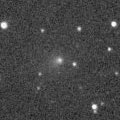
|
Now it is so bright as 8.6 mag (Oct. 23, Marco Goiato). It keeps observable for a long time until 2010 February. It will keep 9 mag until the end of 2009. But in the Northern Hemisphere, it keeps very low after this. It locates a bit higher in the Southern Hemisphere.
Date(TT) R.A. (2000) Decl. Delta r Elong. m1 Best Time(A, h)
Oct. 24 17 38.33 -26 34.9 1.679 1.369 54 8.7 18:39 ( 43, 14)
Oct. 31 18 5.78 -26 45.4 1.708 1.379 53 8.7 18:32 ( 42, 14)
|

|
It reached up to 7.7 mag in summer (Aug. 13, Chris Wyatt). It is fading now, but still bright as 9.6 mag (Oct. 23, Marco Goiato). It will be getting lower gradually after this, and will be too low to observe in December. It keeps observable for a long time after 2010 in the Northern Hemisphere. But in the Northern Hemisphere, it is only observable in the low sky in 2010 spring, then it will be unobservable after that.
Date(TT) R.A. (2000) Decl. Delta r Elong. m1 Best Time(A, h)
Oct. 24 19 10.15 -6 52.6 3.361 3.301 77 9.2 18:39 ( 34, 42)
Oct. 31 19 10.55 -8 36.5 3.511 3.323 70 9.4 18:32 ( 39, 38)
|
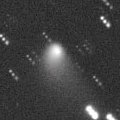
|
Appearing in the morning sky. It is 8.7 mag, as bright as expected (Oct. 16, Juan Jose Gonzalez). It keeps as bright as 9-10 mag for a long time until 2010 spring. It will be observable in good condition for a long time after this in the Northern Hemisphere. It keeps visible visually for one year until 2010 autumn.
Date(TT) R.A. (2000) Decl. Delta r Elong. m1 Best Time(A, h)
Oct. 24 11 33.17 9 47.2 2.914 2.260 41 9.4 4:48 (274, 23)
Oct. 31 11 46.80 10 44.8 2.850 2.268 45 9.4 4:54 (276, 27)
|
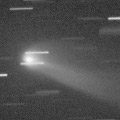
|
An outburst occured on Oct. 13, and it reached up to 8.5 mag on Oct. 15 (Toru Yusa). The central nucleus shined like a bright star, and the dust coma looked like 17P/Holmes in outburst. However, the comet returned to the normal state within a few days. Now it is 10.5 mag (Oct. 24, Marco Goiato). It will keep 10-11 mag until December. In the Northern Hemisphere, it keeps observable in good condition for a long time until 2010 spring when it becomes fainter than 18 mag.
Date(TT) R.A. (2000) Decl. Delta r Elong. m1 Best Time(A, h)
Oct. 24 6 20.07 -4 33.9 0.617 1.352 111 9.9 4:11 ( 0, 50)
Oct. 31 6 24.07 -4 14.0 0.623 1.391 116 10.1 3:47 ( 0, 51)
|
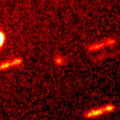
|
Already bright as 11.8 mag and visible visually (Oct. 16, Juan Jose Gonzalez). It will be getting higher after this. It will be observable bright as 9-10 mag in a good condition for a long time from winter to spring. It keeps observable until 2010 autumn when it fades down to 16 mag.
Date(TT) R.A. (2000) Decl. Delta r Elong. m1 Best Time(A, h)
Oct. 24 9 37.59 12 59.6 2.121 1.979 68 12.9 4:48 (291, 48)
Oct. 31 9 52.94 11 47.8 2.020 1.943 71 12.6 4:54 (297, 50)
|
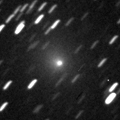
|
It brightened up to 8.5 mag in May and June (May 26, Juan Jose Gonzalez). Now it is fading, but still bright as 11.6 mag (Oct. 10, Marco Goiato). It will never be observable again in the Northern Hemisphere. In the Southern Hemisphere, it will be low temporarily in winter, but it keeps observable until when it fades out.
Date(TT) R.A. (2000) Decl. Delta r Elong. m1 Best Time(A, h)
Oct. 24 15 43.55 -55 25.4 2.804 2.274 48 12.9 18:39 ( 36,-21)
Oct. 31 16 11.51 -55 10.2 2.924 2.352 46 13.2 18:32 ( 36,-20)
|
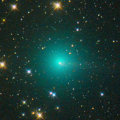
|
It brightened up to 6.7 mag in June (June 9, Marco Goiato). It faded down to 9.5 mag on Aug. 21 (Juan Jose Gonzalez), then it became unobservable. Now it is appearing in the morning sky again at 13 mag. It may be visible visually again.
Date(TT) R.A. (2000) Decl. Delta r Elong. m1 Best Time(A, h)
Oct. 24 13 20.02 9 58.9 3.245 2.364 23 12.9 4:48 (259, 1)
Oct. 31 13 24.00 10 57.9 3.242 2.419 28 13.2 4:54 (262, 8)
|
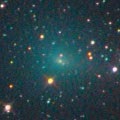
|
It brightened up to 8.8 mag in May and June (May 19, Juan Jose Gonzalez). Now it is still bright as 11.7 mag (Oct. 24, Marco Goiato). However, it will be too faint to see visually in November. It keeps observable in the evening sky for a long time until next spring when it becomes fainter than 18 mag.
Date(TT) R.A. (2000) Decl. Delta r Elong. m1 Best Time(A, h)
Oct. 24 22 43.15 -14 44.4 1.398 2.139 125 13.0 20:31 ( 0, 40)
Oct. 31 22 47.55 -14 6.3 1.504 2.180 120 13.3 20:08 ( 0, 41)
|

|
Now it is 14.2 mag, already visible visually (Oct. 24, Alan Hale). It will brighten rapidly after this. It will reach to 12 mag and become visible visually in winter. In the Northern Hemisphere, it keeps observable in good condition for a long time after this until 2010 spring when it fades out.
Date(TT) R.A. (2000) Decl. Delta r Elong. m1 Best Time(A, h)
Oct. 24 5 59.70 10 39.8 1.377 2.061 119 13.5 3:50 ( 0, 66)
Oct. 31 6 4.42 10 5.9 1.306 2.047 125 13.2 3:28 ( 0, 65)
|

|
It brightened up to 11 mag in spring and summer. Now it is not observable. It will appear in the morning sky at 15 mag in early 2010. But it locates somewhat low in the Northern Hemisphere.
Date(TT) R.A. (2000) Decl. Delta r Elong. m1 Best Time(A, h)
Oct. 24 14 40.86 -16 52.0 3.241 2.280 12 13.8 18:39 ( 77,-11)
Oct. 31 14 55.64 -18 2.8 3.269 2.295 9 13.8 18:32 ( 77,-13)
|

|
An outburst occured in September. It is bright as 12.2 mag still now (Oct. 17, Carlos Labordena).
Date(TT) R.A. (2000) Decl. Delta r Elong. m1 Best Time(A, h)
Oct. 24 9 43.52 13 14.8 6.492 6.170 66 14.0 4:48 (290, 47)
Oct. 31 9 46.38 12 55.3 6.386 6.171 73 14.0 4:54 (297, 52)
|
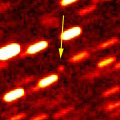
|
It will brighten rapidly after this, and will reach up to 10 mag in December. In the Southern Hemisphere, it keeps observable all through this apparition, although it becomes low in November and December. Especially, it will be observable in the excellent condition after January. In the Northern Hemisphere, it keeps observable in the evening low sky until late November when it becomes 11 mag. It will appear in the morning sky at 14 mag in late January, then it keeps observable while fading gradually.
Date(TT) R.A. (2000) Decl. Delta r Elong. m1 Best Time(A, h)
Oct. 24 17 20.96 -17 27.2 1.132 0.913 50 15.3 18:39 ( 52, 18)
Oct. 31 17 38.72 -19 2.4 1.056 0.828 47 14.3 18:32 ( 52, 16)
|

|
Now it is not observable. It will appear in the morning sky again in 2010 February. It will brighten up to 12-13 mag in 2010 summer. But it locates somewhat low in the Northern Hemisphere.
Date(TT) R.A. (2000) Decl. Delta r Elong. m1 Best Time(A, h)
Oct. 24 14 46.70 -13 19.8 3.525 2.566 13 14.4 18:39 ( 79, -8)
Oct. 31 14 59.30 -14 30.9 3.528 2.553 9 14.4 18:32 ( 79,-11)
|

|
It passed near by the earth in late February, and it reached up to 4.9 mag (Feb. 23, Juan Jose Gonzalez). Now it is fading, but still bright as 14.4 mag (Sept. 23, Yuji Ohshima). It is observable at 15 mag in good condition until winter.
Date(TT) R.A. (2000) Decl. Delta r Elong. m1 Best Time(A, h)
Oct. 24 6 56.83 21 5.3 3.510 3.922 107 14.8 4:48 ( 0, 76)
Oct. 31 6 49.13 21 11.2 3.456 3.994 116 14.8 4:13 ( 0, 76)
|
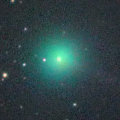
|
It has been observed bright as 8-9 mag from April to June. Now it is fading. It was still bright as 11.0 mag in July (July 12, Marco Goiato). However, no observations have been reported since August. So it may have faded out rapidly. In the Southern Hemisphere, it keeps observable in a good condition for a long time. In the Northern Hemisphere, it will never be observable again.
Date(TT) R.A. (2000) Decl. Delta r Elong. m1 Best Time(A, h)
Oct. 24 10 54.05 -54 46.5 3.368 2.923 55 14.8 4:48 (330,-13)
Oct. 31 10 55.64 -55 46.5 3.420 3.001 57 14.9 4:54 (334,-11)
|

|
Brightening very rapidly, faster than expected. Now it is 14.6 mag (Oct. 19, Ken-ichi Kadota). It will reach up to 14 mag in winter, and maybe it will be visible visually. It keeps observable in good condition all through the time until next spring when it becomes fainter than 18 mag.
Date(TT) R.A. (2000) Decl. Delta r Elong. m1 Best Time(A, h)
Oct. 24 7 33.41 5 28.1 0.822 1.356 96 15.1 4:48 (343, 59)
Oct. 31 7 56.12 4 49.0 0.785 1.340 97 14.9 4:54 (348, 59)
|

|
It brightened up to 11.5 mag in last summer (Aug. 4, Marco Goiato). Now it is 15.2 mag (Sept. 20, Yasukazu Ikari). It keeps observable in good condition for a long time in the Southern Hemisphere. Now it became observable again also in the Northern Hemisphere. It will keep 15-16 mag until next spring.
Date(TT) R.A. (2000) Decl. Delta r Elong. m1 Best Time(A, h)
Oct. 24 6 24.63 -42 12.0 4.077 4.329 98 14.9 4:15 ( 0, 13)
Oct. 31 6 18.28 -42 35.3 4.072 4.380 101 15.0 3:41 ( 0, 12)
|

|
It brightned up to 10 mag from late 2008 to early 2009. Now it is fading. But it is still bright as 14.6 mag (Sept. 27, Hidetaka Sato). It will be observable in good condition again in winter at 15 mag. Then it may be still visible visually.
Date(TT) R.A. (2000) Decl. Delta r Elong. m1 Best Time(A, h)
Oct. 24 10 15.14 8 39.2 5.220 4.769 58 15.0 4:48 (288, 38)
Oct. 31 10 18.56 7 57.2 5.176 4.824 63 15.0 4:54 (295, 43)
|
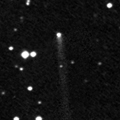
|
Now it is 15.4 mag (Sept. 25, Hidetaka Sato). It keeps observable in good condition at 15 mag until late autumn. It has a very long tail in spite of the distance.
Date(TT) R.A. (2000) Decl. Delta r Elong. m1 Best Time(A, h)
Oct. 24 23 15.91 31 3.6 3.177 3.980 138 15.0 21:03 ( 0, 86)
Oct. 31 23 9.53 31 9.1 3.248 3.992 133 15.1 20:30 ( 0, 86)
|
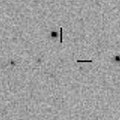
|
It will be 14 mag from winter to spring in 2010. But the condition is bad. Now it is not observable in the Northern Hemisphere, but it is observable in good condition in the Southern Hemisphere. It keeps observable until mid January in the Southern Hemisphere. In the Northern Hemisphere, it will appear in the morning sky at 15 mag in late May in 2010, then it keeps observable while fading gradually after that.
Date(TT) R.A. (2000) Decl. Delta r Elong. m1 Best Time(A, h)
Oct. 24 18 14.62 -59 32.6 2.321 2.147 67 15.3 18:39 ( 19,-10)
Oct. 31 18 38.76 -57 23.7 2.331 2.105 64 15.2 18:32 ( 20, -8)
|

|
It is expected to reach up to 10 mag and to be observable in good condition in 2010 spring. Now it is not observable in the Northern Hemisphere. It will be unobservable also in the Southern Hemisphere in late November. Then it will appear in the morning sky at 13 mag in late January.
Date(TT) R.A. (2000) Decl. Delta r Elong. m1 Best Time(A, h)
Oct. 24 16 19.46 -40 43.2 3.511 2.867 43 15.3 18:39 ( 45, -8)
Oct. 31 16 26.88 -39 20.2 3.517 2.796 37 15.2 18:32 ( 48, -9)
|

|
Now it is 14.6 mag (Sept. 19, Hidetaka Sato). It passes the perihelion in September, and now it is brightest. It keeps observable in good condition in the Southern Hemisphere. In the Northern Hemisphere, it will be getting higher while fading.
Date(TT) R.A. (2000) Decl. Delta r Elong. m1 Best Time(A, h)
Oct. 24 20 14.04 -21 24.7 0.901 1.346 90 15.2 18:39 ( 10, 33)
Oct. 31 20 36.73 -16 0.9 0.971 1.387 89 15.4 18:32 ( 10, 39)
|

|
Now it is 14.4 mag and visible visually (Sept. 14, Alan Hale). It keeps 15 mag until winter. It keeps observable in a good condition in the Southern Hemisphere. But in the Northern Hemisphere, it will be getting lower gradually, and it is only observable until late autumn.
Date(TT) R.A. (2000) Decl. Delta r Elong. m1 Best Time(A, h)
Oct. 24 22 56.41 -36 17.5 2.074 2.669 116 15.3 20:44 ( 0, 19)
Oct. 31 22 49.33 -38 24.6 2.169 2.649 107 15.4 20:09 ( 0, 17)
|
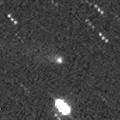
|
Now it is 15.9 mag (Sept. 26, Hidetaka Sato). It keeps 15 mag until 2010, and will be observable for a long time in good condition.
Date(TT) R.A. (2000) Decl. Delta r Elong. m1 Best Time(A, h)
Oct. 24 15 31.79 27 5.4 3.405 2.799 45 15.6 18:39 (108, 23)
Oct. 31 15 33.11 25 44.1 3.443 2.807 43 15.7 18:32 (109, 19)
|

|
Now it is 16.2 mag (Aug. 13, Ken-ichi Kadota), brightening as expected. It will reach up to 12 mag in 2012, and will be observable visually at 12-13 mag for a long time from 2011 to 2013. In 2009, it is observable in good condition at 16 mag from summer to autumn. In the Northern Hemisphere, the comet will be low around its brightest seasons.
Date(TT) R.A. (2000) Decl. Delta r Elong. m1 Best Time(A, h)
Oct. 24 21 46.29 0 43.5 7.797 8.306 117 15.7 19:34 ( 0, 56)
Oct. 31 21 43.78 0 20.0 7.874 8.269 110 15.7 19:04 ( 0, 55)
|

|
Fading slowly. Now it is 15.5 mag (Oct. 19, Ken-ichi Kadota). It keeps observable in good condition until February when it becomes fainter than 18 mag.
Date(TT) R.A. (2000) Decl. Delta r Elong. m1 Best Time(A, h)
Oct. 24 9 39.76 14 48.9 2.188 2.041 68 15.8 4:48 (289, 49)
Oct. 31 9 48.79 13 41.4 2.161 2.094 72 16.0 4:54 (296, 52)
|

|
New periodic comet. Brightening very rapidly. Now it is 16.2 mag (Oct. 16, D. Levy, W. Levy, T. Glinos). It will brighten up to 15 mag and will be observable in good condition in winter.
Date(TT) R.A. (2000) Decl. Delta r Elong. m1 Best Time(A, h)
Oct. 24 1 41.68 17 12.1 0.984 1.976 173 16.3 23:29 ( 0, 72)
Oct. 31 1 40.10 13 52.8 0.956 1.941 170 16.0 23:00 ( 0, 69)
|
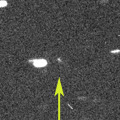
|
It brightened up to 11 mag in outburst in 2003. Now it is 16.5 mag (Oct. 10, La Sagra). It will be observable in good condition in winter. Maybe it brightens up to 14 mag.
Date(TT) R.A. (2000) Decl. Delta r Elong. m1 Best Time(A, h)
Oct. 24 23 27.63 11 16.0 0.977 1.876 144 16.4 21:15 ( 0, 66)
Oct. 31 23 23.57 10 39.7 0.976 1.829 136 16.2 20:44 ( 0, 66)
|

|
Now it is 17.8 mag (Sept. 20, Yasukazu Ikari). It will brighten rapidly after this, and will be observable at 15 mag in good condition in winter and spring. It may be visible visually.
Date(TT) R.A. (2000) Decl. Delta r Elong. m1 Best Time(A, h)
Oct. 24 5 30.94 13 30.6 1.673 2.408 127 16.6 3:22 ( 0, 69)
Oct. 31 5 32.33 13 19.8 1.578 2.374 133 16.4 2:56 ( 0, 68)
|
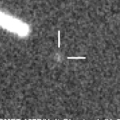
|
It became much brighter than expected. It was originally predicted to be 19 mag, but now it is 16.4 mag (Sept. 25, Hidetaka Sato). It will be observable in good condition at 17-18 mag until November.
Date(TT) R.A. (2000) Decl. Delta r Elong. m1 Best Time(A, h)
Oct. 24 0 43.01 8 12.4 1.228 2.196 162 16.7 22:30 ( 0, 63)
Oct. 31 0 37.82 8 43.1 1.260 2.197 154 16.8 21:58 ( 0, 64)
|
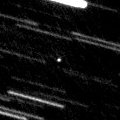
|
It passed the perihelion in June, but it was not observable, too close to the sun. Although it was predicted to be 13.5 mag, the STEREO spacecraft revealed that it brightened up to 10-11 mag, much brighter than expected. Now it is 16.4 mag (Aug. 23, C00). It keeps observable at 16-17 mag until late autumn.
Date(TT) R.A. (2000) Decl. Delta r Elong. m1 Best Time(A, h)
Oct. 24 1 40.91 46 32.2 1.054 1.954 145 16.8 23:26 (180, 79)
Oct. 31 1 17.90 43 34.2 1.091 2.001 147 16.8 22:36 (180, 82)
|
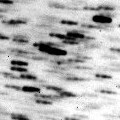
|
Now it is 16.7 mag (Aug. 14, Katsumi Yoshimoto). The condition is good in this apparition. It will approach to the earth down to 0.38 A.U., and will be observable in good condition at 16.5 mag in November. It keeps observable until that time after this. But it locates somewhat low in the Northern Hemisphere.
Date(TT) R.A. (2000) Decl. Delta r Elong. m1 Best Time(A, h)
Oct. 24 19 10.09 -16 20.1 0.454 0.991 76 17.0 18:39 ( 29, 34)
Oct. 31 19 46.96 -14 38.0 0.423 0.999 78 16.8 18:32 ( 25, 37)
|

|
Now it is 17.4 mag (Sept. 16, A. Novichonok, V. Nevski, D. Chestnov). The condition of this apparition is bad. It will reach up to 11-12 mag from spring to autumn in 2010, but it is not observable. It will be getting brighter gradually in the evening sky, but it will be too low to observe in January at 15 mag.
Date(TT) R.A. (2000) Decl. Delta r Elong. m1 Best Time(A, h)
Oct. 24 20 23.06 -1 8.7 2.460 2.763 96 17.0 18:39 ( 11, 53)
Oct. 31 20 26.87 -1 30.7 2.510 2.717 91 16.9 18:32 ( 18, 52)
|
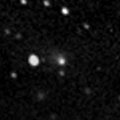
|
It brightened up to 15-16 mag in 2008 summer. Now it is 17.4 mag (Sept. 15, A. Novichonok, V. Nevski, D. Chestnov). It keeps observable at 17 mag in good condition for a long time until winter.
Date(TT) R.A. (2000) Decl. Delta r Elong. m1 Best Time(A, h)
Oct. 24 3 47.23 35 20.5 2.301 3.168 145 17.0 1:39 (180, 90)
Oct. 31 3 42.05 35 35.6 2.276 3.185 151 17.0 1:06 (180, 89)
|

|
First return of a new bright periodic comet. It was observed as an asteroid in June, however, it unexpectely brightened up to 12.3 mag on Aug. 31 (Juan Jose Gonzalez). It was bright as 13.6 mag and visible visually still on Sept. 20 (Seiichi Yoshida). However, it is fading rapidly. It has already faded down to 17.4 mag (Oct. 10, Ken-ichi Kadota). It will be fainter than 18 mag in November.
Date(TT) R.A. (2000) Decl. Delta r Elong. m1 Best Time(A, h)
Oct. 24 8 50.61 25 17.5 0.701 1.140 82 17.1 4:48 (284, 64)
Oct. 31 8 54.55 25 42.9 0.721 1.214 88 17.7 4:54 (292, 70)
|

|
Now it is 17.0 mag (Oct. 18, Ken-ichi Kadota). This comet tends to brighten after the perihelion passage. It will reach up to 16-17 mag in 2010 and 2011.
Date(TT) R.A. (2000) Decl. Delta r Elong. m1 Best Time(A, h)
Oct. 24 5 1.80 25 36.8 2.467 3.234 133 17.2 2:53 ( 0, 81)
Oct. 31 5 0.28 25 35.5 2.396 3.228 140 17.1 2:24 ( 0, 81)
|

|
Now it is 17.2 mag (Sept. 4, Ken-ichi Kadota). It keeps observable at 17-18 mag for a long time until 2011.
Date(TT) R.A. (2000) Decl. Delta r Elong. m1 Best Time(A, h)
Oct. 24 3 0.29 80 20.3 4.610 5.051 110 17.4 0:54 (180, 45)
Oct. 31 2 15.75 81 11.6 4.567 5.036 112 17.3 23:32 (180, 44)
|
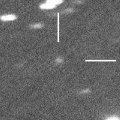
|
Now it is 18.0 mag (Sept. 21, Mt. Lemmon Survey). It keeps observable at 17 mag for a long time from 2010 to 2012.
Date(TT) R.A. (2000) Decl. Delta r Elong. m1 Best Time(A, h)
Oct. 24 3 15.24 20 3.6 7.837 8.771 158 17.4 1:07 ( 0, 75)
Oct. 31 3 10.03 19 51.4 7.785 8.755 166 17.4 0:34 ( 0, 75)
|

|
It will be observable at 15.5 mag in the evening sky from winter to spring.
Date(TT) R.A. (2000) Decl. Delta r Elong. m1 Best Time(A, h)
Oct. 24 3 46.92 15 30.9 1.523 2.448 152 17.8 1:38 ( 0, 70)
Oct. 31 3 36.77 17 26.5 1.415 2.377 161 17.5 1:01 ( 0, 72)
|

|
No observations have been reported recently, but it will be brightening rapidly after this. It will reach up to 15 mag from winter to spring, and will be observable in good condition.
Date(TT) R.A. (2000) Decl. Delta r Elong. m1 Best Time(A, h)
Oct. 24 9 19.83 19 51.0 2.552 2.478 74 17.9 4:48 (287, 55)
Oct. 31 9 30.57 19 19.8 2.450 2.459 78 17.7 4:54 (293, 59)
|

|
It will reach up to 17.5 mag and will be observable in good condition in November and December.
Date(TT) R.A. (2000) Decl. Delta r Elong. m1 Best Time(A, h)
Oct. 24 4 55.41 23 52.5 1.646 2.455 135 18.0 2:47 ( 0, 79)
Oct. 31 4 26.32 25 7.5 1.524 2.427 148 17.8 1:51 ( 0, 80)
|
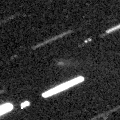
|
Comet Pigott, which has been lost over 200 years since 1783, is identified with a comet discovered in 2003 by LINEAR. Now it is 17.6 mag (Sept. 11, Catalina Sky Survey). Getting higher, but it will be fainter than 18 mag in October.
Date(TT) R.A. (2000) Decl. Delta r Elong. m1 Best Time(A, h)
Oct. 24 9 34.64 52 5.4 2.181 2.308 84 17.9 4:48 (226, 57)
Oct. 31 9 51.90 53 33.7 2.152 2.345 88 18.1 4:54 (222, 59)
|
|
![]()
 C/2009 O4 ( Hill )
C/2009 O4 ( Hill ) C/2008 N1 ( Holmes )
C/2008 N1 ( Holmes ) C/2006 S3 ( LONEOS )
C/2006 S3 ( LONEOS ) 64P/Swift-Gehrels
64P/Swift-Gehrels P/2009 T2 ( La Sagra )
P/2009 T2 ( La Sagra ) 157P/Tritton
157P/Tritton 30P/Reinmuth 1
30P/Reinmuth 1 127P/Holt-Olmstead
127P/Holt-Olmstead (3200) Phaethon
(3200) Phaethon 107P/(4015) Wilson-Harrington
107P/(4015) Wilson-Harrington 43P/Wolf-Harrington
43P/Wolf-Harrington 47P/Ashbrook-Jackson
47P/Ashbrook-Jackson 222P/2009 MB9 ( LINEAR )
222P/2009 MB9 ( LINEAR ) 203P/2008 R4 ( Korlevic )
203P/2008 R4 ( Korlevic ) C/2007 VO53 ( Spacewatch )
C/2007 VO53 ( Spacewatch ) C/2008 S3 ( Boattini )
C/2008 S3 ( Boattini ) C/2009 U3 ( Hill )
C/2009 U3 ( Hill ) 94P/Russell 4
94P/Russell 4 C/2009 T3 ( LINEAR )
C/2009 T3 ( LINEAR ) 226P/2009 R2 ( Pigott-LINEAR-Kowalski )
226P/2009 R2 ( Pigott-LINEAR-Kowalski )![]()

































